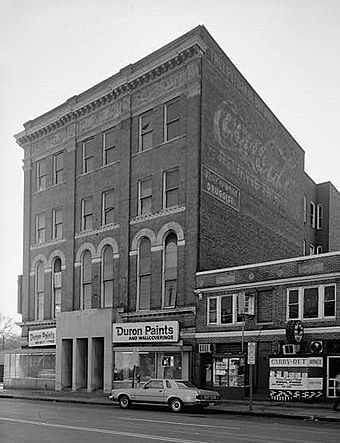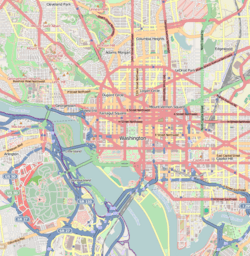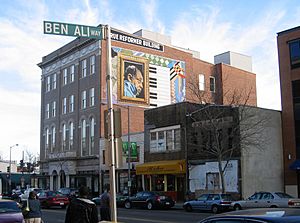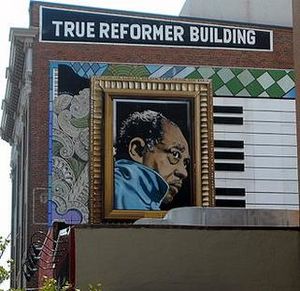True Reformer Building facts for kids
Quick facts for kids |
|
|
True Reformer Building
|
|
|
U.S. Historic district
Contributing property |
|
 |
|
| Location | 1200 U Street, NW, Washington, District of Columbia |
|---|---|
| Area | 0.3 acres (0.12 ha) |
| Built | 1903 |
| Architect | John Anderson Lankford |
| Part of | Greater U Street Historic District (ID93001129) |
| NRHP reference No. | 88003063 |
| Added to NRHP | January 9, 1989 |
The True Reformer Building is a very important historical building in Washington, D.C.. It was built for an African American group called the True Reformers. This group was started by William Washington Browne.
The building is located at 1200 U Street in the U Street Corridor neighborhood. It was designed by John Anderson Lankford, a talented architect. The True Reformers asked for the building to be built in 1902, and it was officially opened on July 15, 1903.
Contents
A Special Building
The Grand United Order of True Reformers began as a group that encouraged people to live healthy lives and avoid alcohol. This was part of a larger movement called the Temperance movement. In 1876, William Washington Browne was asked to help start a new part of this movement in Richmond, Virginia.
When people started to lose interest in the temperance part, Browne changed the group. He made it into an insurance organization. This meant he moved to Richmond in 1880. Over time, the True Reformers grew very big.
- They managed a bank.
- They ran a newspaper called the Reformer.
- They owned many properties.
- At one point, they were the largest Black fraternal society and Black-owned business in the United States.
Building for the Future
When the True Reformer Building was opened in 1903, Reverend William Lee Taylor said its goal was to "put up a building in Washington that would reflect credit upon the Negro race." This means they wanted to build something that would make the African American community proud.
It was very special because:
- An African American architect designed it.
- African Americans provided the money to build it.
- African American workers built it with their own hands.
The True Reformer Building was the first building in the United States after the Reconstruction Era that was designed, paid for, built, and owned entirely by the African American community. John Anderson Lankford, who designed it, was the first African American registered architect in Washington, D.C.
In 1909, a book was published about the group's first 25 years.
Challenges and Changes
The True Reformers were very successful while William Washington Browne was alive. However, after he passed away, the organization faced big problems in 1910. Some employees were dishonest with money, and businesses that owed the True Reformers money did not pay them back. These problems caused the organization to collapse.
A.W. Holmes became the president of the group in 1911. They tried to save the organization and reorganize it.
Ownership Changes
Over the years, the True Reformer Building had different owners.
- In 1917, a group called the Knights of Pythias bought the building.
- From 1937 to 1959, the Boys Club of the Metropolitan Police of the District of Columbia used the building. Eleanor Roosevelt, the First Lady at the time, even helped rededicate the building.
Other groups that used the building included:
- The Washington Conservancy
- The D.C. Chapter of the National Negro Business League
- The First Separate Battalion
A famous musician, Duke Ellington, gave his very first performance here!
The building was added to the National Register of Historic Places in 1989. This means it is recognized as an important historical site.
In 1999, the Public Welfare Foundation bought the building. They had it fixed up and made new from late 2000 to early 2001.
Art on the Building
A large mural (a painting on a wall) by G. Byron Peck used to be on the side of the building. It showed Duke Ellington. This mural could be seen from the U Street Metro station.
- The mural was finished in 1997.
- It was first on the sidewall of a place called Mood Indigo.
- Later, it was moved to the True Reformer Building.
- In 2012, the mural was taken down to be restored (fixed up).
- Sadly, it was too damaged to put back in 2013.
- But on May 3, 2019, a new copy of the mural was put back on the building!
See also
 In Spanish: True Reformer Building para niños
In Spanish: True Reformer Building para niños




